#Fruit #Salad #Costume #Jewelry #Perfect #Dish #Collectors
There are lots of nicknames costume jewelry collectors have given their favorite styles over the years. None are so fun, perhaps, as “Fruit Salad.” This term pertains to adornment made by one of the giants in the costume jewelry business to imitate a particular type of Art Deco era fine jewelry. And, as with many other terms associated with high-end costume jewelry, this one is often used incorrectly to draw attention in online listings.
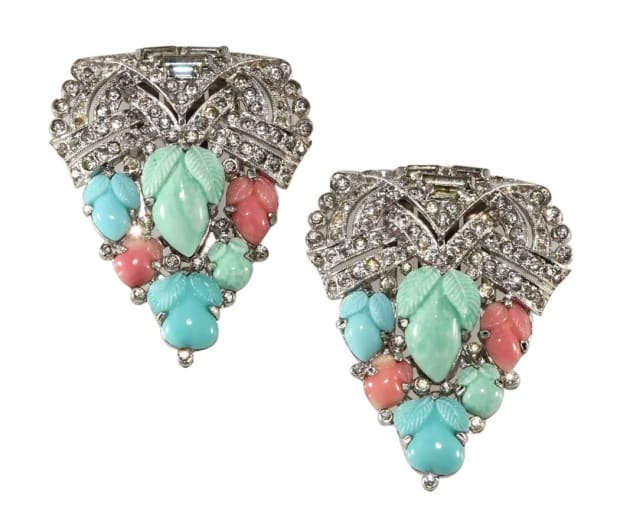
Courtesy Jay B. Siegel
Fruit Salad Jewelry Origins
We like to think of costume jewelry companies and designers as great innovators, and some of them certainly have marketed their share of unique creations. Very often, though, fine jewelry styles have trickled down to yield some of the most popular and costly costume jewelry designs over the years. Pieces made with Fruit Salad stones fall into this category.
Before there was Fruit Salad made by top costume jewelry businesses in the 1930s and beyond, there was Tutti Frutti by Cartier. The term Tutti Frutti, which is still in use today, describes carved emeralds, sapphires, and rubies shaped like fruits, flowers, and leaves set into precious metals. Other accompanying stones are dome shaped or ribbed, and of course there are almost always diamond accents sprinkled within these magnificent pieces.
Cartier called these designs “foliage” or “Hindou jewels” when they were first made in the 1920s and ’30s. Much like the term Art Deco coming about in the late 1960s, Tutti Frutti wasn’t coined to describe these works of wearable art until the 1970s.
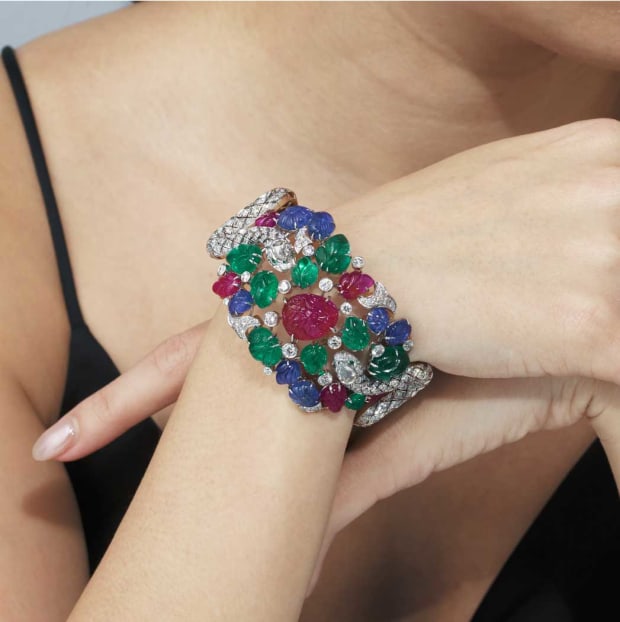
Courtesy Christie’s
Jacques Cartier, who ran the London branch of his family’s famed French jewelry house, was responsible for bringing the carved stones back to Europe from India. He would quickly share them with his brother Louis, the heir of Cartier. Both men were greatly inspired by not only these carved jewels, but the culture of India. They channeled their scholarly pursuits on the topic into the creation of some truly outstanding jewels.
These vividly colored imported gemstones were not as fine as some of the others being used in Cartier jewelry during the period. This led the first Tutti Frutti pieces to be priced lower in comparison to designs crafted with more flawless stones. As noted in The Cartiers: The Untold Story of the Family Behind the Jewelry Empire by Francesca Cartier Brickell, these pieces were all about color, so quality wasn’t as much of a concern.
Socialite Daisy Fellowes embraced everything about the exotic look of Tutti Frutti designs and had Cartier create the famed Collier Hindou in 1935 using her own stash of carved gems. It was a convertible necklace that could be taken apart to wear the central element as a clip brooch. Tutti Frutti designs on par with that piece are still being produced for Cartier’s high jewelry collections today.
Marketing Fruit Salad Jewelry
Trifari is the undisputed winner of the inspired by Cartier prize when it comes to imitations of Tutti Frutti jewelry. This shouldn’t be too surprising since their lead designer, Alfred Philippe, worked for Cartier before joining the Rhode Island-based firm in 1930.
By that time, Tutti Frutti jewelry was already being marketed to Cartier’s elite customers. Demand had shifted due to the Great Depression, however, and Philippe was inspired to design similar styles with imitation stones for Trifari. Most of these pieces are marked with the initials TKF for Trifari, Krussman and Fishel, the early signature used by Trifari. Decades later, just like Tutti Frutti, the stones in these pieces were nicknamed Fruit Salad.
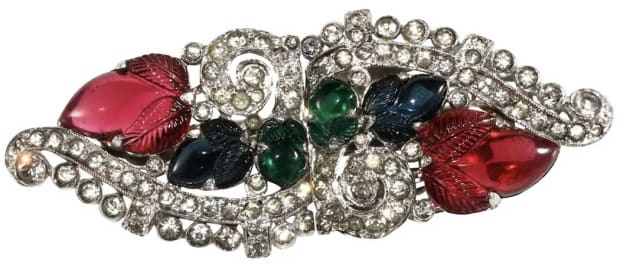
Courtesy Jay B. Siegel
While Fruit Salad stones are often described as carved by sellers, they’re actually made of molded glass rather than hand carved like genuine gemstones. In addition to the jewel-toned colors of green, blue, and red popularized by Cartier, Trifari branched out to include imitations of moonstone, turquoise, coral, and other gems. The shapes include tiny lemons, pears, melons, and leaves.
Trifari, like Cartier, was also known for making convertible jewelry. Trifari’s versions featuring imitations of carved gemstones include a particularly rare and desirable bracelet with a pair of the brand’s Clip-mates dress clips fastened at the top. The clips can be removed and worn separately, and other Clip-mate styles can be swapped in their place. Clip-mates were also made into convertible “duette” brooches that can be worn together as a pin or separated into two clips.
Some other jewelry companies made their own versions of jewelry using colorful molded glass stones. Mazer is the most prolific in terms of what collectors describe as Fruit Salad. The stones in this brand’s pieces are usually molded glass leaves or flowers but sometimes include fruit shapes. While these stones were used sporadically later, and those designs are desirable as well, the most sought-after Fruit Salad designs date to the 1930s. Later styles by Trifari will be marked with the crown over the T signature rather than TKF.
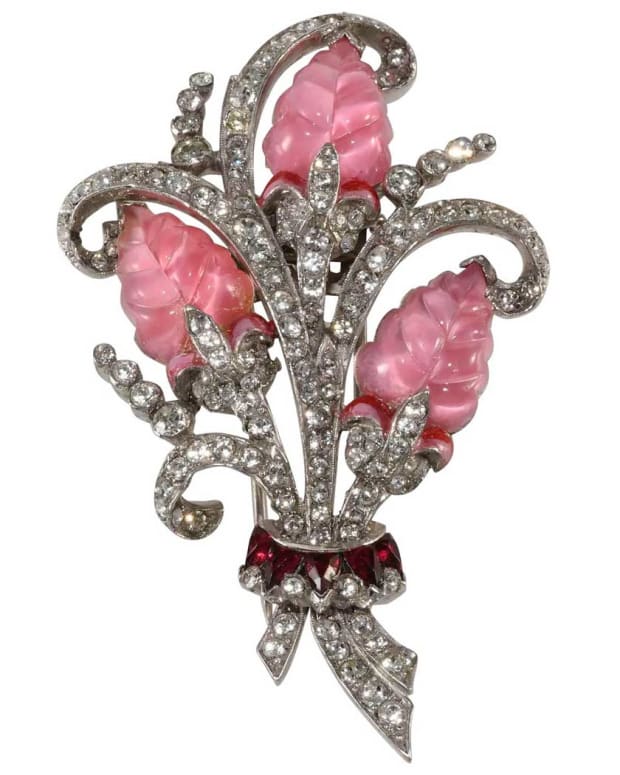
Courtesy Jay B. Siegel
What Fruit Salad Jewelry Isn’t
Online sellers sometimes take license in describing their wares, especially in listing titles. Fruit Salad is a term used incorrectly quite often, and sometimes it’s a case of mistaken identity when a piece contains oodles of colorful stones. Some describe Italian glass or plastic fruit jewelry as Fruit Salad simply because they include fruit shaped beads. Other sellers, however, use the term intentionally to draw attention.
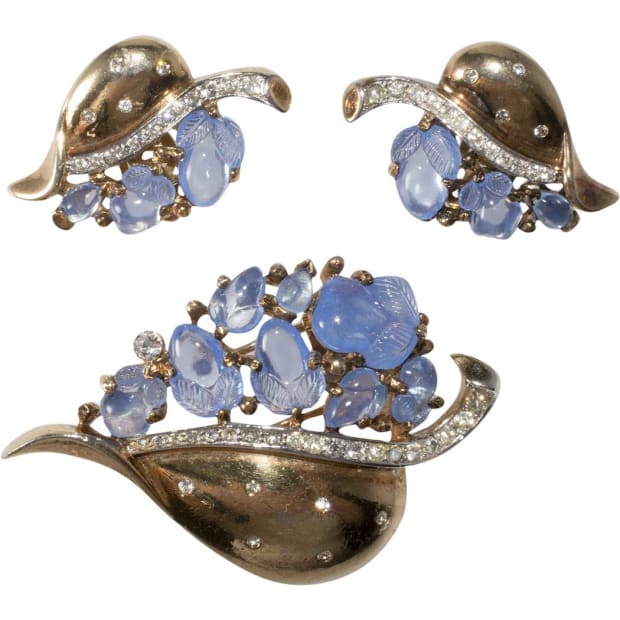
Courtesy Jay B. Siegel
Why does this even matter? At the end of the day, most collectors just look at the jewelry and scroll on if it’s not described correctly. They do take notice, however, and tend to avoid sellers who habitually describe things inaccurately feeling they may be overlooking flaws or other pertinent details. Bottom line, if you want to be seen as a trustworthy, do your research and save the term Fruit Salad for stones that mimic the look of carved gemstones shaped like fruits, leaves and flowers.
Values for Fruit Salad Jewelry
While you might not be able to afford a piece of Cartier Tutti Frutti jewelry for your collection, you just might be able to snag a Fruit Salad piece that’s more in your price range with some shopping diligence. Smaller brooches and pairs of earrings start in the $125 to $300 range with prices going up from there. Many of the Trifari designs from the 1930s, though, easily sell in the thousands now.
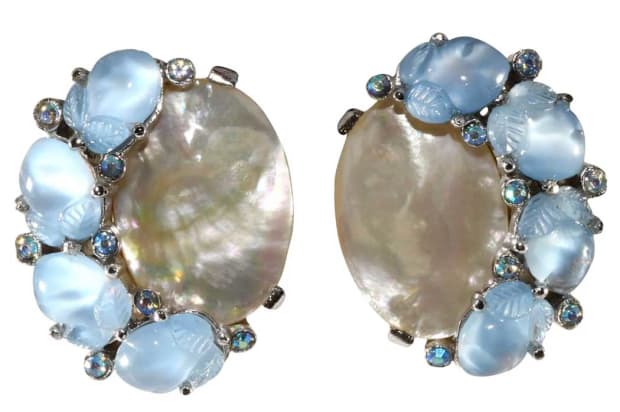
Courtesy Jay B. Siegel
Demand is strong in this area of costume jewelry collecting, especially from Asian buyers, so values are on the way up. Keep that in mind as you contemplate a purchase since the nicest pieces don’t stay on the market for long now when priced to sell.
You May Also Like:
How to Identify Unmarked Costume Jewelry
